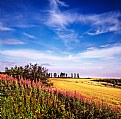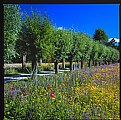|
|
 Nick Karagiaouroglou
Nick Karagiaouroglou
 {K:127263} 4/27/2006
{K:127263} 4/27/2006
|
Hi Michael!
Well, theory is not only "nice" but much more than this: It is essential and elementary! Without the theory of optics, for example, we wouldn't have any cameras at all.
Now for some maths. In your second paragraph you refer to a "1400 pixel wide image" - but unforunately this alone doesn't say anything at all, since we don't know what the size of the pixel is. The number of pixels alone is not informative at all. It is the number of pixels in *a defined length* that makes sence, and this is the resolution. For example, if those 1400 pixels have to cover a length of 1 inch, then you have 1400 pixels/inch, which results in a linear pixel size of 0.02mm, which is a good resolution. If they cover 1 ft, then we have a linear pixel size of 0.2mm which is bad.
Now, assuming that these 1400 pixels are distributed along a length of about 30mm (linear size of a film exposition area) we come to a linear pixel size of 0.02mm which OK, but also stunning, since this would mean that the chromophoric molecules on the film (the molecular "pixels") are... visible! (If somebody ever has seen a molecule, then please show it to me ;-))
So, what happens here? Since a "molecular pixel" of linear dimension of 0.2mm is a bit too big to be true, the explanation has to be searched elsewhere. It turns out that most of the time not single molecules but whole groups of molecules on the film are activated by the incident light. And the groups can contain really many molecules. Such a molecular group is og course much bigger than a single molecule and so the "pixel" that they represent is also too large. But really good photographers are able through their immense experience to keep these groups so small, that they get excellent results.
24 Megapixels of a digizal camera are very very very poor when we want to have a photo magnified at, say, 1m*1m for an exhibition. The linear size of the printed pixel will then be at least 0.2mm which is rather bad.
So we see: On the one hand we have the garantied 24 megapixels of the digital camera. No matter what happens during exposition they are there. And this is of course great because it frees one from all the headaches so that one can think much more about the composition. But on the other hand, the immense potential resolution of the film may have great problems to be used efficiently, but if somebody can use it as efficiently as possible, then the resulting pictures will be unbelievable!
Cheers!
|
|
|
|
 Michael Kanemoto
{K:22115} 4/26/2006
Michael Kanemoto
{K:22115} 4/26/2006
|
Nick:
Theory is nice.
I used a 1965 MF Nikon until 2003. Over the counter ISO 200 Kodak or Fuji film has a grain size equivalent to a 1400 pixel wide image. (the grain = pixel). The rough equivalent is about 3 MPxl.
For the over the counter user using ISO 100 or 200 the 6 megapixel image will blow away the general film cannister.
For those lucky and fortunate users of medium format, they can average about 24 megapixels (color) unless they use ISO 100 or less. Incredible, but within 5 years the SLR market will catch up.
For those very very lucky people who use 8 x 10 or larger formats (like the gigapixel project) I got nothin'. That's a class of specialization that I think all of us should admire.
The same for artists who decided to hook up flatbed scanners to large format film bodies and use panoramic stitching software.
In all practical senses I went digital after I finally wore the light tight foam off the back of my camera. That, and shooting 20 rolls of film was just too expensive.
I also don't have to think about chemicals.
I admire the old school, I came from the old shool, but the practical measures and break even happened somewhere a few years ago.
|
|
|
|
 Nick Karagiaouroglou
Nick Karagiaouroglou
 {K:127263} 4/26/2006
{K:127263} 4/26/2006
|
Thank you for the info on digital photography, Michael. I wouldn't use photoshop for many reasons though.
Considering digital photography being crisper, cleaner and more detailed, well, from the theoretical point of view and assuming perfect photography and perfect proecessing, the film is worlds ahead. Just calculate how many megapixels there are on film having about 100nm (molecular scale!) as linear size of one "pixel", that is, one molecule.
There are other reasons why digital photography is prefered, but from the physical point of view digital photography will reach the quality potential of a film only when the size of a single light receptor on the CCD reaches molecular dimensions. Of course this will come with time, but for the moment any comparison of the 12-20 megapixels of a digital camera with the approx. 85000 (!) megapixels of the film is a bit.. funny. Same goes for the maximum number of colors.
Of course the existence of such a huge possible resolution doesn't mean that it can automatically be used so easily. And here come the problems of film. The learning curve is much flatter and all those subtle effects quite hard to control. A great amount of experience is needed for the right handling, since we may have all kinds of helping means on film cameras, but at the end we simply can't see what's on the film before the process comes to an end.
Long story, isn't it, but worthy mentioning, I think.
Thanks again and keep on shooting digital, film, hybrid or any other available technology of your choise.
Nick
|
|
|
|
 Michael Kanemoto
{K:22115} 4/26/2006
Michael Kanemoto
{K:22115} 4/26/2006
|
Nick:
Digital cameras do have the eqivalent of film grain - it is digital noise, and can occur when you push the CCD into higher ISOs. You can also introduce noise into the image in photoshop or other programs through a filter.
However, digital photography is much crisper, cleaner, and in general more detailed than film.
|
|
|
|
 Shyamal Addanki
{K:1009} 4/25/2006
Shyamal Addanki
{K:1009} 4/25/2006
|
Yes, much better!
|
|
|
|
 Nick Karagiaouroglou
Nick Karagiaouroglou
 {K:127263} 4/25/2006
{K:127263} 4/25/2006
|
Many thanks, Doyle!
|
|
|
|
 Nick Karagiaouroglou
Nick Karagiaouroglou
 {K:127263} 4/25/2006
{K:127263} 4/25/2006
|
Thank you so much for the kind comment, Ian!
Cheers!
|
|
|
|
 Nick Karagiaouroglou
Nick Karagiaouroglou
 {K:127263} 4/25/2006
{K:127263} 4/25/2006
|
Thans a bunch for the nice and detaile comment, Michael. That grainyness is something very special to me and I often push photos, sometimes a bit too much also. But here it was only the Supra film.
Since I never used a digital camera, may I ask, if there are also ways to do that with such a camera? I think there must be many ways, or am I mistaken?
Many thanks again and best wishes!
|
|
|
|
 Nick Karagiaouroglou
Nick Karagiaouroglou
 {K:127263} 4/25/2006
{K:127263} 4/25/2006
|
Great thanks for the detailed and nice comment, Giuseppe! That was exactly what I thought of, multiple copies in different directions vanishing away.
Thank you and best wishes!
|
|
|
|
 Nick Karagiaouroglou
Nick Karagiaouroglou
 {K:127263} 4/25/2006
{K:127263} 4/25/2006
|
Many thanks for your kind comment, Nicola!
Cheers!
|
|
|
|
 Nick Karagiaouroglou
Nick Karagiaouroglou
 {K:127263} 4/25/2006
{K:127263} 4/25/2006
|
Many thanks for the nice comment, Shyamal! I cropped that part off - what do you think?
Best wishes,
Nick
|

Cropped |
|
|
|
 Doyle D. Chastain
Doyle D. Chastain
 {K:101119} 4/25/2006
{K:101119} 4/25/2006
|
Nicely composed!
Regards,
Doyle I <-----
|
|
|
|
 Ian McIntosh
{K:42997} 4/25/2006
Ian McIntosh
{K:42997} 4/25/2006
|
Just enough movement apparent. These flowers glowing in your setting nicely.
|
|
|
|
 Michael Kanemoto
{K:22115} 4/24/2006
Michael Kanemoto
{K:22115} 4/24/2006
|
Nick:
Excellent use of subtle lighting and shallow Dof to really make this image stand out. good use of the rule of thirds, strong composition, but overall the Supra film really brought out some lovely colors and film grain.
This shot makes me miss film just a little bit...
Thanks for the memory and a great shot.
|
|
|
|
 Giuseppe Guadagno
Giuseppe Guadagno
 {K:34002} 4/24/2006
{K:34002} 4/24/2006
|
Compliments Nick: really beautiful the vanishing copies of the subject. The background seems excellent to me.
Very good work.
Good night!
|
|
|
|
 Nicola Barbieri
{K:18000} 4/24/2006
Nicola Barbieri
{K:18000} 4/24/2006
|
<Nice macro and colors...ciao, Nicola
|
|
|
|
 Shyamal Addanki
{K:1009} 4/24/2006
Shyamal Addanki
{K:1009} 4/24/2006
|
I like the Depth of field very much, and I like the affect and mood that this picture creates. However, the stem on the left is slightly distracting to me. Very nice image overall, though. Gives a sense of silence.
|
|
















